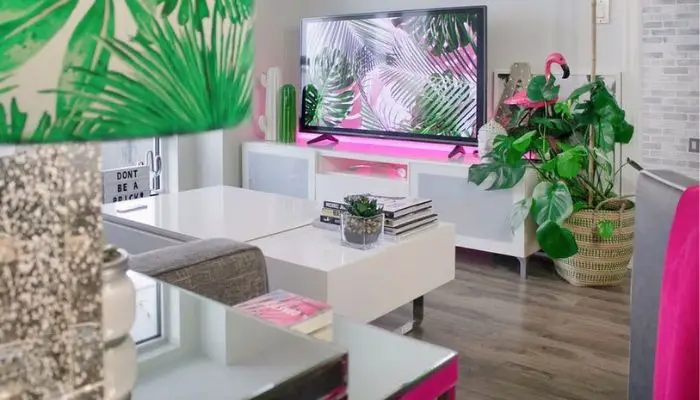When you turn on your LCD TV to find that it has suddenly developed a new display fault—dark shadows—you are as surprised as you are irritated. It seems as though there are several dark spots dispersed over your television screen.
It may be just in one spot, but it’s messing up your entire viewing experience. Beginners are at a significant disadvantage because they cannot determine what is causing the issue or what they should do about it. Ignore all of the internet naysayers who insist that you must purchase a new television.
It’s possible that you can fix your LCD TV all by yourself. In the following discussion, I will completely guide you on fixing Dark Shadow on LCD TV? There are many potential explanations for why you are observing shadows on your television.
Shadowing on your television can be caused by several things, the most common of which are burn-in, an improperly placed LCD TV, and defective cables. Most of the time, shadowing happens when you keep a static image on the screen for an extended period.
Therefore, if no one is present to watch the LCD television make a habit of turning it off. In a few quick and easy stages, we will walk you through the process of repairing the black shadows on your LCD TV. You do not require to wait for a long time before you can start viewing your favorite show while taking in images of the highest possible quality.
Reasons for Shadowing Effect on LCD TV
There are many possible reasons for the presence of a shadowy figure on your LCD tv screen.
Burn-In
Burn-in occurs when a still image is left on an LCD TV for too long. Paused DVDs or menu screens are the most common reasons to produce a dark shadow on LCD TV. When panel pixels break, they remember prior hues. Even after removing an image, your TV will continue to display those colors, creating shadows.
Video Cables
When using an HDMI cable with external devices, a shadow picture may appear on the screen. It is not usually due to the cable but rather the external device’s video output settings combined with an HDMI connection. Changing the external device’s output settings or using a component cable are options.
A High Degree of Heat
Temperature and humidity might alter your TV’s display. Matrix delamination and LED failure have been recorded to cause a shadowing effect on LCD TV.
Wall-Mounting Error
To avoid pixel damage, you must evenly distribute your TV’s weight across its body. Overtightened screens can potentially cause display difficulties over time. Due to the TV’s uneven illumination, these flaws appear as black shadows on the screen.
3-D LCD TVs
3D televisions may have a shadow effect. It happens if you’re not sitting directly in front of the TV. Many 3-D TVs still require special glasses to deliver transparent, shadow-free images.
Efficient Ways to Fix Dark Shadow on LCD TV

Follow the efficient methods outlined below.
Method 1#By Cleaning the LCD Display
It doesn’t have to be harder to get rid of the hazy black spots on your TV. More so if any of the following brought them on
- A buildup of sand and dirt
- You cover the TV screen in foreign materials.
Cleansing the screen will bring it back to its original state in this scenario. With this, your LCD TV will be able to display without any problems. Here’s how to clean the LCD TV without damaging your screen.
Step 1: Disconnect the television from the wall and turn it off. When the TV is on, do not pressure the screen.
Step 2: To clean the screen, use a microfiber or 100% cotton cloth. Line up your wipes. Clean the LCD TV from top to bottom of the screen.
Step 3: If there are any stubborn streaks, gently rub them with your fingertips in circular motions.
Step 4: Step 2 should be repeated until the clouded area has been eliminated.
Method 2# By Modifying the Input
Step 1: When you observe a dark shadow on your TV screen, the TV’s input is connected to plays a role.
Step 2: A problem with the device you connected to the input may be the source of the shadow appearing.
Step 3: Check to verify if the dark shadow only shows in the input you initially noticed by switching inputs.
Step 4: Check if the dark shadow goes away by restarting the input device.
Method 3# By Turning on the Light Sensor
Depending on the quantity of light present in the room, your TV’s light sensor adjusts the brightness. When the room is dark, the brightness should be reduced automatically.
If there is light in the surroundings, the brightness should go up. This setting is meant to provide you with an immersive cinematic experience at any time of day.
To use your TV’s built-in light sensor, you’ll need to switch the settings on. It may help you get rid of the dark shadow on your screen.
Step 1: Toggle the “Menu” button on your TV remote.
Step 2: Go to the picture settings or the setup menu on your computer.
Step 3: Activate the “Light Sensor” option.
Step 4: Switch it on if it isn’t already
Step 5: While viewing the television, switch the lights on and off to see if the screen is working correctly. The haze should dissipate soon. There may be a problem with your LCD TV sensor if the brightness doesn’t adjust with the illumination.
Method 4# By Using a Lower or Higher Power-saving Setting
You might alleviate shadow patches on your TV by modifying your power-saving settings. Power-saving mode reduces the brightness of your TV screen to save electricity.
Turning on power-saving mode may help clear up any foggy patches on your screen. In a dimly lit room, this could be incredibly useful. Additionally, you will save money on your electric bill as a result. Changing your power-saving settings is as simple as following these steps:
Step 1: You can access the TV menu by pressing the “Menu” button on the remote control of your television
Step 2: Go to the configuration menu of your program.
Step 3: Switch to a more energy-efficient mode. The mode can be changed from “Low” to “High” or vice versa. The screen should now be in equilibrium.
Step 4: While watching TV, take a look at the screen. By now, the haze should have cleared.
Method 5# By Restarting The LCD TV
If the dark shadow remains after you have adjusted the backlight, then trying to troubleshoot the issue by restarting the TV is a strategy that has a good chance of being successful. It is because a restart can do a soft reset on the system, which in turn has the potential to get rid of both the software bug that is creating the black shadow.
You can restart your TV by using the menu options; following the procedures outlined below will allow you to restart an LCD TV from the options menu.
Step 1: Put the TV on standby.
Step 2: Take the TV’s power cord out of the wall socket.
Step 3: At a minimum, wait thirty seconds after unplugging the TV before reconnecting it.
Step 4: Put the TV back in the air.
Step 5: Check to see whether the dark shadow has vanished; if it hasn’t, you may replace the display, or the device may require a reset to factory settings.
Method 6# By Loosening LCD TV Screws
LCD televisions are frequently over-tightened, which is another factor that contributes to the gradual deterioration of their images over time. It results in unevenness in the backlighting, which manifests itself on the screen as cloudy spots.
Step 1: Stop watching television and remove the plug from the wall socket by using a screwdriver.
Step 2: Loosen the screws located around the top edge of the TV’s rear panel. Please keep them in play but rotate the board by a quarter turn.
Step 3: Reconnect the cables to the television and power it on.
Step 4: Check to see if the screen is cloudy. If the problem persists, try switching off the TV, unplugging it, and retightening the screws.
Method 7# By Stabilizing the Back of the LCD TV
The critical thing you have to do is check that your television is appropriately supported. The clouding problem may worsen if you move your LCD TV around a lot of travel it frequently. You ought to position your television in a spot where it will not be disturbed. The following are some techniques to steady your TV: Experiment with mixing these strategies if you have young children living in your home.
Step 1: Adjusting the screws that are located on the bottom of your television
Step 2: Putting your television on a cabinet or stand specifically designed for it
Step 3: securing your television to the wall with a bracket is recommended.
Frequently Asked Question
What Causes Dark Shadow on TV Screen?
When an image is exhibited on an LCD TV for a long time, dark shadows can emerge. LCD pixels can be temporarily colored. Image retention or burn-in describes this issue.
How Do I Fix the Shadow on My Screen?
Remove any magnetic, electrical, speaker, lamp, or fan near the computer. Disconnect any devices sharing the same wall outlet or circuit as the monitor. Turn off the computer’s fluorescent illumination.
What Is a LCD Shadow?
Using static images for an extended period might leave behind a persistent shadow or ghost on the screen. An AMOLED display is the most likely culprit in most of these instances.
Conclusion
Although a burn-in or a wall-mounting error are the most common causes of the black shadow, it is possible that you will not need to replace the screen to fix the issue. Use any of the steps I’ve outlined above to diagnose the problem with the LCD TV and find out if a software defect caused it.
If that’s the case, I’m sure you’ve picked up some helpful information about Fixing Dark Shadow on LCD TV by reading this page. Avoiding call-out fees and even the expense of purchasing a new television is possible.

